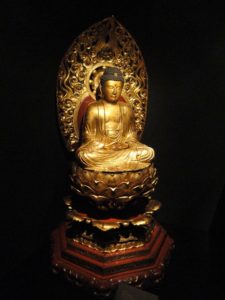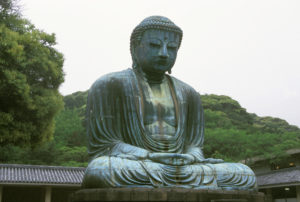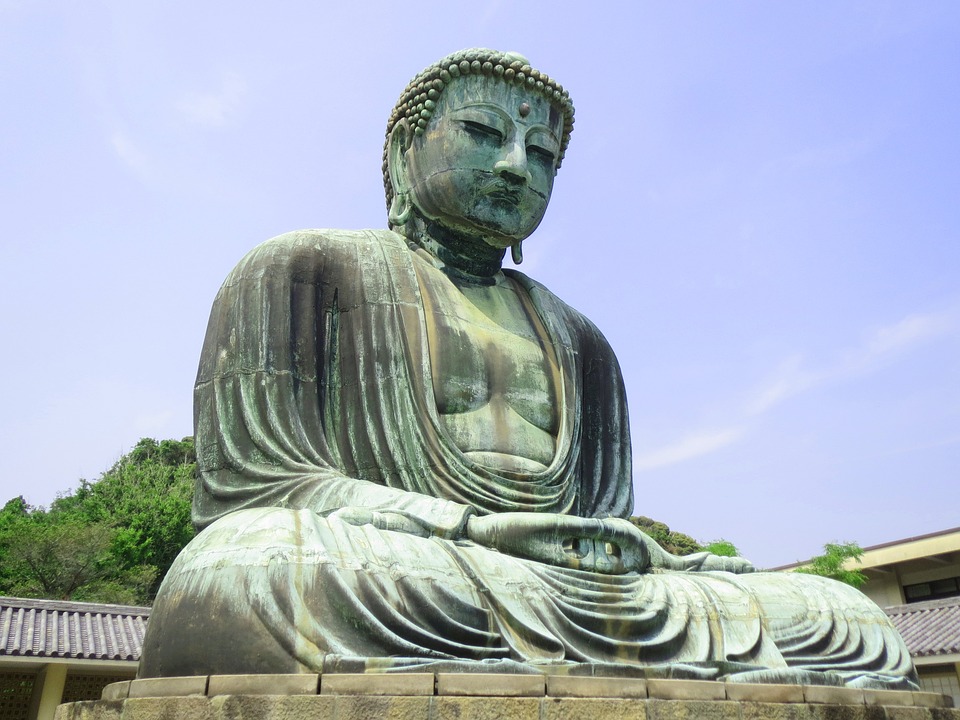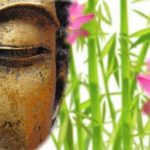“I am Amida, Buddha of the moon-lit garden,
I welcome those who seek truth and liberation,
I offer them the lotus seat of welcome.”
Dharmakara was born a powerful Indian king, who gave up his kingdom to seek Enlightenment. To do so, he made the 48 Vows, promising what he would do if he were to become a Buddha. Through these efforts, Dharmakara (now known as the Amida Buddha) created the Pure Land, a place of bliss and serenity. And he promised that anyone who lived with faith, joy, compassion and repeated his name ten times would be reborn there. To invoke him, one must say “Namu Amida Butsu,” or “All hail the Amida Buddha.”
 Amida Buddha belongs to a sect of Buddhism known as Mahayana Buddhism. In Mahayana Buddhism, before one reaches Enlightenment they have the opportunity to become a bodhisattva, who will guide and help all those seeking Nirvana. Most bodhisattvas reward good behavior, encourage meditation and help those who seek wisdom. But Amida is different, he helps us realize our own foolishness, for it is only by admitting that we know nothing, that we can find the ultimate truth. He also offers us all a wonderful place in the afterlife. Any ‘sentient being’ can be his follower and he cares for all life equally.
Amida Buddha belongs to a sect of Buddhism known as Mahayana Buddhism. In Mahayana Buddhism, before one reaches Enlightenment they have the opportunity to become a bodhisattva, who will guide and help all those seeking Nirvana. Most bodhisattvas reward good behavior, encourage meditation and help those who seek wisdom. But Amida is different, he helps us realize our own foolishness, for it is only by admitting that we know nothing, that we can find the ultimate truth. He also offers us all a wonderful place in the afterlife. Any ‘sentient being’ can be his follower and he cares for all life equally.
Japanese Buddhism
Because of this, Amida is one of the most revered figures in Japanese Buddhism, with a huge following. Originally seen as a bodhisattva for the masses, he gained a larger following as the years passed. Like all forms of Buddhism, the worship of Amida began in Southeast Asia, where the first evidence of him can be found in Pakistan, circa 200CE. He first appears in Japan in the 11th century CE. He was introduced by a monk named Genshin (942-1017), and developed by Honen (1133-1212).
Due to his immense popularity, Amida becomes a popular figure in the artwork. Much of it showed him descending to guide his followers into the afterlife, often accompanied by his two assistants, Avlokitesvara and Mahasthamaprapta. There are also many statues dedicated to him. Usually, he is shown seated, his hands posed in meditation, or carrying a lotus flower. But sometimes, his right hand is positioned over his right knee, palm turned down.
The Great Buddha of Kamakura
There is also a massive statue dedicated to him, The Great Buddha of Kamakura. Originally a large wooden statue, built-in 1243, it was replaced with a bronze version after the first was destroyed in a fire.
 It’s unknown if this statue is the same as the one currently in the temple, or if it was remade during the intervening years. It is 13.35 meters tall and weighs 93 tons. Although it is completely hollow, no one is allowed to go inside, after it was subject to vandalism. In addition to painting graffiti on its interior, many of the golden lotus petals that once decorated the base of the statue have been stolen.
It’s unknown if this statue is the same as the one currently in the temple, or if it was remade during the intervening years. It is 13.35 meters tall and weighs 93 tons. Although it is completely hollow, no one is allowed to go inside, after it was subject to vandalism. In addition to painting graffiti on its interior, many of the golden lotus petals that once decorated the base of the statue have been stolen.
Because of the considerable cultural difference between Western and Eastern countries, it is important to note that the term ‘Amida’ literally means ‘symbol.’ Amida is not a real historical figure, but an abstract concept given form. No one believes that he really lived because what he represents is more important than who he was.





